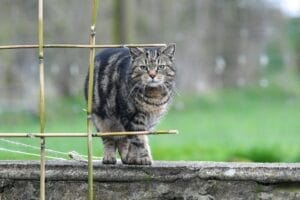There’s nothing quite as concerning as coming home to find your feline friend distressed and anxious due to separation. In this informative guide, you’ll discover practical tips and tricks to help ease your cat’s separation anxiety. By implementing these strategies, you can create a more comfortable and secure environment for your furry companion when you’re away. Let’s research into understanding and addressing your cat’s separation anxiety together.
Key Takeaways:
- Understand the signs: Educate yourself on the common signs of feline separation anxiety such as excessive meowing, destructive behavior, and litter box issues.
- Create a safe environment: Provide your cat with comfortable hiding spots, interactive toys, and scratching posts to keep them engaged and reduce anxiety levels when alone.
- Gradual desensitization: Practice leaving your cat alone for short periods of time and gradually increase the duration to help them get accustomed to being on their own.
Identifying Feline Separation Anxiety

Before delving into how to address feline separation anxiety, it’s vital to first identify whether your feline friend is experiencing this common issue.
Common Signs and Symptoms
Feline separation anxiety can manifest in various ways, including excessive meowing, destructive behavior, urinating or defecating outside the litter box, excessive grooming, or even aggression. If your cat displays these behaviors consistently when you leave the house or are out of sight, they may be suffering from separation anxiety.
Distinguishing from Other Behavioral Issues
Other behavioral problems can sometimes mimic the signs of feline separation anxiety, making it important to distinguish between them. This can include medical issues like urinary tract infections or other health problems that may cause similar symptoms. Additionally, general boredom or lack of stimulation can lead to destructive behaviors that may be mistaken for separation anxiety.
This is why it’s crucial to observe your cat’s behavior closely and, if you’re unsure, consult with a veterinarian or animal behaviorist for a proper diagnosis.
Causes of Feline Separation Anxiety
Genetic Predisposition
While feline separation anxiety can be influenced by various factors, genetic predisposition plays a significant role. On a genetic level, some cats may be predisposed to developing separation anxiety due to their breed or lineage. Certain breeds, such as Siamese or Burmese cats, are thought to be more prone to this condition than others. If your cat has a history of anxiety-related issues in their family tree, they may be more susceptible to experiencing separation anxiety.
Environmental Factors
- Changes in routine or environment
- Loss of a companion
- Traumatic experiences
Genetic predisposition aside, environmental factors can also contribute to the development of feline separation anxiety. Changes in routine or environment, such as moving to a new home or a sudden shift in your schedule, can trigger anxiety in some cats. The loss of a companion, whether human or animal, can also lead to feelings of insecurity and anxiety in your feline friend. Traumatic experiences, such as loud noises or being left alone for extended periods, can further exacerbate your cat’s anxiety levels.
Recognizing these potential triggers can help you better understand your cat’s behavior and provide them with the support and comfort they need to overcome their separation anxiety.
Changes in the Household
With changes in the household, such as the addition of a new family member or a furry friend, your cat may experience heightened levels of stress and anxiety. Introducing new dynamics into their living space can disrupt their sense of security and routine, leading to feelings of unease and insecurity.
Changes in the household dynamics can significantly impact your cat’s emotional well-being and may manifest as separation anxiety. It’s necessary to monitor your cat’s behavior closely during times of change and provide them with extra reassurance and attention to help them adjust to their evolving environment.
- Loss of a companion
- Changes in routine or environment
- Introducing a new family member or pet
Recognizing the signs of distress in your cat during times of change can help you address their separation anxiety and create a more secure and comforting living environment for them.
Preparing for Your Absence

Gradual Separation Techniques
An imperative aspect of addressing feline separation anxiety is preparing your cat for your absence. An effective way to do this is by gradually getting your cat used to being alone for short periods. Start by leaving your cat alone in a separate room for a few minutes and gradually increase the time as your cat becomes more comfortable being by itself. This will help your cat learn that being alone is not a cause for panic.
Leaving a Familiar Object Behind
With cats being creatures of habit, leaving a familiar object behind can provide them with a sense of comfort and security while you are away. This could be an item of your clothing that carries your scent or a favorite toy that your cat loves to play with. Having this familiar object nearby can help reduce your cat’s stress and anxiety during your absence.
Familiar scents and objects can help reduce your cat’s anxiety and provide a sense of security when you are not around. This familiarity can soothe your cat and make them feel more at ease in your absence, reducing the likelihood of them exhibiting anxious behaviors.
Providing Mental Stimulation
Leaving your cat with mental stimulation activities can help keep their mind occupied and alleviate boredom while you are away. Interactive toys, puzzle feeders, or simply hiding treats around the house for them to find can engage your cat’s cognitive abilities and prevent them from feeling anxious or lonely in your absence.
It is imperative to keep your cat mentally stimulated to prevent boredom and anxiety from setting in while you are away. Providing activities that challenge your cat’s mind and cater to their natural instincts can help keep them content and mentally sharp even when you are not there.
Creating a Calming Environment
Pheromone Therapy
One way to create a calming environment for your feline friend is to consider pheromone therapy. Pheromones are chemical substances that can help alleviate stress and anxiety in cats by mimicking natural pheromones that cats release. Products like diffusers, sprays, and collars containing synthetic pheromones can help create a sense of calm and security for your cat.
Soothing Music and White Noise
For a relaxing atmosphere, you can also try playing soothing music or white noise in your home. Soft, calming music or white noise can help drown out loud noises from outside and create a more peaceful environment for your cat. The gentle background sounds can have a comforting effect on your feline companion.
Plus, music specifically designed for cats, with sounds that mimic purring or birds chirping, can be particularly soothing for your pet. Experiment with different types of music to see what has the most calming effect on your cat.
Calming Aids and Products
Noise-canceling headphones and calming aids like anxiety vests or blankets can also help create a peaceful environment for your cat. These products provide gentle pressure that can have an anxiety-reducing effect on your feline friend. Additionally, there are supplements and treats available that contain natural ingredients known to promote relaxation in cats.
This combination of pheromone therapy, soothing music, and calming aids can significantly contribute to creating a calming environment for your cat and help alleviate their separation anxiety.
Exercise and Play Before Leaving
Tire Them Out: Physical Activity
Once again, before you leave your feline friend alone, it’s important to ensure they have had enough physical activity to tire them out. Engaging your cat in active playtime can help reduce anxiety and stress levels. A tired cat is more likely to relax and rest while you’re away.
Mental Stimulation: Interactive Toys
Any cat owner knows that mental stimulation is just as important as physical exercise. Interactive toys, such as puzzle feeders or laser pointers, can provide your cat with mental challenges that keep their minds sharp and engaged. These toys can also help distract your cat and keep them entertained while you’re not around.
Tire your cat out mentally as well as physically to ensure they don’t become bored or anxious in your absence. Providing a variety of stimulating toys can help prevent destructive behavior that may stem from separation anxiety.
Reducing Stress Through Play
With a variety of toys and activities, you can help reduce your cat’s stress levels before you leave. Interactive play sessions not only provide physical and mental stimulation but also create a bond between you and your cat. This bonding time can help your cat feel more secure and less anxious when you’re not at home.
Stress reduction through play is a great way to build a routine that your cat can rely on. Consistent playtime before you leave can signal to your cat that everything is okay and that you will return, reducing their anxiety about being alone.
Managing Your Cat’s Anxiety While You’re Away
Many cats experience anxiety when left alone for extended periods. To help ease your feline friend’s stress when you’re not around, consider hiring a pet sitter or asking a neighbor to check in on your cat. Having someone stop by to provide food, playtime, and companionship can greatly reduce your cat’s feelings of isolation and anxiety while you’re away.
Hiring a Pet Sitter or Asking a Neighbor
On occasions when you have to be away for longer periods, having someone familiar come over to spend time with your cat can provide comfort and alleviate their anxiety. A pet sitter can follow your cat’s routine, offering feeding, playtime, and social interaction that mimic your presence. A trusted neighbor can also offer support by checking in on your cat, ensuring they feel cared for and secure in your absence.
Providing a View or Window Perch
Away from home for extended periods, it’s beneficial to provide your cat with a view of the outside world. A window perch allows your cat to observe outdoor activities, such as birds and passing cars, which can serve as entertainment and mental stimulation. This visual stimulation can help keep your cat engaged and distracted from their anxiety, making their time alone more bearable.
Providing a safe and comfortable perch near a window can offer your cat a sense of security and enrichment while you’re away. Positioning a cozy bed or cushioned spot near a window with a view can give your cat a peaceful and entertaining space to relax in, reducing their feelings of isolation and anxiety.
Summing up
With these considerations in mind, you can now take proactive steps to help alleviate your feline companion’s separation anxiety. By gradually acclimating your cat to your departure and making your absence less distressing, you can create a calmer environment for your pet.
Keep in mind, each cat is unique, so the key is to observe your cat’s behavior and adjust your strategies accordingly. With patience, consistency, and love, you can help your furry friend feel more secure and content when you’re not at home.
FAQ
Q: What are the signs of feline separation anxiety?
A: Cats may exhibit behaviors such as excessive meowing, destructive scratching or chewing, urinating outside the litter box, and clinging behavior when experiencing separation anxiety.
Q: How can I help my cat cope with separation anxiety?
A: You can help your cat cope with separation anxiety by providing a comfortable and safe environment, engaging in interactive play before leaving, leaving comforting items such as clothing with your scent, and gradually desensitizing your cat to your departure cues.
Q: Are there any products or remedies that can help alleviate feline separation anxiety?
A: There are products such as pheromone diffusers, calming collars, and supplements that can help alleviate feline separation anxiety. Consult with your veterinarian to determine the best option for your cat.











